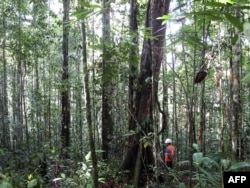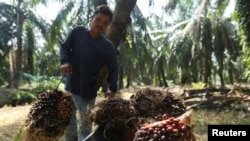Indonesia and Malaysia, regular fixtures among the world’s annual forest loss leaders, both lost less primary forest than the year prior for the fifth year running in 2021, according to new data.
The U.S.-based World Resources Institute, which released its latest figures on global forest losses last month, called the Southeast Asian countries welcome “exceptions” in what was otherwise yet another bleak year for forests worldwide. WRI and others warn, though, that a host of mounting forces could start pushing forest losses in both countries up again in coming years.
According to WRI, Indonesia lost about 203,000 hectares of primary forest last year, down from 270,000 hectares the year before, and well below a peak of 929,000 hectares in 2016. Primary forest losses in Malaysia meanwhile fell from roughly 73,000 hectares in 2020 to 72,000 hectares last year.
Their losses pale in comparison to those of forest loss leader Brazil, where 1.55 million hectares vanished last year.
Southeast Asia’s forests, and Indonesia’s especially, still matter in the global fight against climate change, though, said Elizabeth Goldman, a WRI senior research manager.
“Forests store and sequester carbon, and when these forests are cut down or burned or otherwise degraded then the stored carbon within the forests — the wood, the leaves and all the biomass — can be released into the atmosphere as emissions. And Indonesia still has a lot of humid primary forest. ... It has the third-largest primary forest ... in the tropics,” she told VOA.
The tropics’ primary rainforests, old-growth forests largely untouched by human activity, are some of the most carbon-rich and biodiverse ecosystems in the world.
That is why the falling losses in Indonesia and Malaysia are so encouraging, said Goldman, not only for them, but as an example to others.
“When a country sees losses go down for one or two years we’re always sort of cautiously optimistic, because there can be fluctuations in the data. But a five-year-in-a-row decline I think is reason to celebrate and shows that things are working, in Indonesia especially,” she said.
‘All coming together’
WRI credits a mix of government policies and corporate commitments for the gains Indonesia and Malaysia have been making.
Indonesia has had a moratorium on the clearing of primary forests since 2011, made permanent in 2019, and another on issuing new permits for palm oil plantations since 2018. Taking a different tack, Malaysia in 2019 committed to clearing no more than 600,000 new hectares of forest for palm oil up to 2023 to slow down its own forest losses.
Indonesia and Malaysia are the world’s first- and second-largest producers of palm oil, respectively, and together fill 85% of the world’s supply of the popular plant extract, used in everything from instant noodles to cosmetics to biofuel. The countries’ plantations also account for the bulk of their forest losses. Keen to stay plugged into an increasingly climate-conscious global supply chain, though, more and more of the plantations are adopting so-called NDPE policies — No Deforestation, No Peatland, No Exploitation.
Goldman said the Indonesian government has also stepped up its fire management and response system since 2016, when devastating fires accounted for more than 40% of the country’s tree cover loss.
“It’s difficult to quantify exactly how much each of these policies or practices are contributing to the decline, but it seems like it’s all coming together to have a positive impact,” she said.
Forest losses have “definitely been declining, which is great,” agreed Chris Wiggs, Indonesia program director for Aidenvironment, a Netherlands-based group that works on making development sustainable. He said NDPE policies, in particular, have had a “massive impact,” with 83% of palm oil refining capacity across Indonesia and Malaysia now on board.
He also pointed to important forces at play beyond government or corporate control.
Consecutive years of heavy rains have made much of Indonesia’s remaining forests too waterlogged to clear, he said, while pandemic restrictions have left many companies planning to develop plantations short-staffed. Fluctuations in global palm oil prices over the past few years have also made it riskier to invest in their development, he added.
Trouble ‘on the horizon’
Some of the same forces pushing forest losses down are due to expire soon, or have already done so, raising fears that losses could start to level off or even rise again.
Goldman noted that the recent run of wet years is due to end in 2022 with the return of El Niño, a cyclical weather phenomenon that brings Southeast Asia higher temperatures and, with them, the risk of more severe droughts and forest fires.
Palm oil prices — which tend to drive plantation development up or down, depending on which way they go, after about a year — have been rising sharply since mid-2020. Indonesia chose not to renew its freeze on new palm oil plantation permits in September, while Malaysia’s cap on new forest clearing for plantations expires next year.
Wiggs said Indonesia’s push to develop its biofuel industry also poses a risk, with some companies rejected by international palm oil traders for continuing to encroach on forests finding ready local buyers in the fuel business. He said new laws aimed at spurring job growth also strip away some important environmental safeguards, including the rights local communities had to appeal a project’s environmental impact assessment.
Arie Rompas, forest campaign team leader for Greenpeace Indonesia, said even the country’s 2021 losses were far too high, and that current policies and practices were likely to keep driving heavy forest losses “into the foreseeable future.”
Goldman and Wiggs are more encouraged by the direction Indonesia and Malaysia are headed for now. But they, too, worry that some of the forces already in motion and on the way could yet turn them around.
Goldman makes a cautionary tale of Brazil, which saw annual forest losses fall for five years in a row in the 2000s only to have them level off and rise again.
“So, it’s something we’ve seen happen in other places, where the trend has gone down but is ticking back up,” she said. “If we’re not careful about some of these things on the horizon, we could see that happen here as well.”




